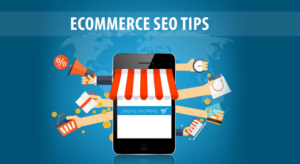E-commerce SEO isn’t just a tool; it’s the cornerstone of a successful online business. In this comprehensive guide, we’ll explore the world of E-commerce SEO and unravel the best practices to optimize your online store. Let’s begin this journey toward heightened visibility and increased sales.

The Essence of E-commerce SEO
E-commerce SEO is all about fine-tuning your online store to be search engine-friendly, ensuring your products are visible to potential customers. From optimizing product pages to enhancing user experience, each aspect plays a crucial role in determining your store’s success.
To start, conduct keyword research to understand what your target audience is searching for. Tailor your content and product descriptions around these keywords to maximize visibility. Additionally, optimizing images, improving page load speed, and ensuring mobile responsiveness are equally essential for an effective E-commerce SEO strategy.
Creating SEO-Friendly Product Pages
Product pages are the lifeblood of any online store. Crafting SEO-friendly product pages involves optimizing product titles, descriptions, and metadata. Ensure that your titles are not only descriptive but also contain relevant keywords to enhance search engine ranking. Engage your customers with compelling product descriptions that highlight features, benefits, and usage. Don’t forget to include high-quality images and videos, as visual content significantly impacts a user’s purchase decision.
For seamless navigation, incorporate clear calls-to-action (CTAs) and an intuitive layout. Simplify the buying process with easy-to-find add-to-cart buttons and visible price displays. Streamline the checkout process to reduce cart abandonment rates, ultimately contributing to higher conversions.
Streamlining Site Architecture for SEO
Site architecture plays a pivotal role in E-commerce SEO. An organized and easily navigable website structure not only improves the user experience but also aids search engine crawlers in understanding and indexing your content effectively. Categorize your products logically and use clear, concise URLs that include relevant keywords. Implement breadcrumb navigation to enhance user understanding of the site’s hierarchy.
Ensure that your website is easy to navigate on both desktop and mobile devices. Implement a clear internal linking structure, directing users to related products or categories. The better the navigation, the higher the likelihood of users finding what they’re looking for and completing a purchase.
The Power of User-Generated Content
Harnessing the power of user-generated content can significantly boost your E-commerce SEO efforts. Encourage customers to leave reviews, ratings, and comments on your product pages. User-generated content not only adds a sense of authenticity to your website but also serves as a source of long-tail keywords that potential customers might be using.
Leverage user-generated content in your product descriptions or testimonials to build trust and credibility. Showcase real-life images or videos of customers using your products. Engaged and satisfied customers can become your brand advocates, contributing to a positive online reputation.
SEO for E-commerce Blogs
Blogs are a fantastic way to engage your audience, provide valuable information, and improve your site’s SEO. Develop a blog section on your online store to share insightful content related to your products, industry trends, or how-to guides. Optimize your blog posts by integrating relevant keywords naturally and creating informative, well-structured content.
Regularly update your blog with fresh, valuable content that resonates with your target audience. Encourage social sharing to increase the reach of your blog posts. A well-optimized blog can drive organic traffic to your online store, establishing your brand as an authority in your niche.
Section 6: Embracing Local SEO for E-commerce
Local SEO is indispensable for online stores that serve a specific geographic area. Incorporate location-specific keywords in your product descriptions, titles, and metadata. Create a Google My Business listing to enhance local visibility and encourage customer reviews.
Leverage local backlinks by collaborating with local businesses or participating in community events. Ensure that your business information is consistent across all online platforms. Local SEO is a powerful tool to attract local customers and drive foot traffic to your physical store, if applicable.
Optimizing for Voice Search
With the rise of smart speakers and virtual assistants, optimizing for voice search is becoming increasingly important for E-commerce SEO. Voice searches are typically longer and more conversational. Tailor your content to match these patterns and include question-based keywords to align with how users phrase voice search queries.
Focus on providing concise, direct answers to potential customer queries. Make sure your online store is mobile-friendly, as a significant portion of voice searches happens on mobile devices. By adapting your E-commerce SEO strategy to accommodate voice search, you position your online store to tap into a rapidly evolving digital landscape.
Conclusion
In the ever-evolving landscape of online commerce, mastering E-commerce SEO is not just an option; it’s a strategic necessity. The journey we’ve embarked upon through this guide illuminates the vital strategies and practices that can propel your online store to the forefront of the digital marketplace.

